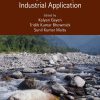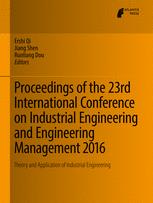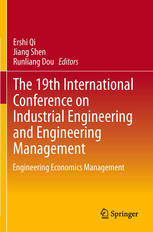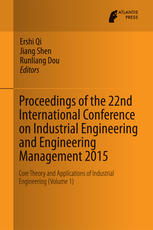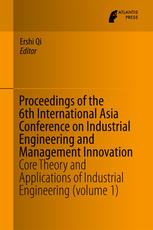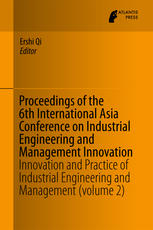Proceedings of the 22nd International Conference on Industrial Engineering and Engineering Management 2015 1st Edition by Ershi Qi 9789462391765 9462391769
$50.00 Original price was: $50.00.$25.00Current price is: $25.00.
Proceedings of the 22nd International Conference on Industrial Engineering and Engineering Management 2015 1st Edition by Ershi Qi – Ebook PDF Instant Download/Delivery:9789462391765,9462391769
Full download Proceedings of the 22nd International Conference on Industrial Engineering and Engineering Management 2015 1st Edition after payment
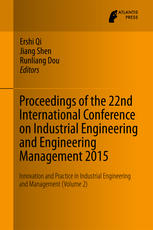
Product details:
ISBN 10:9462391769
ISBN 13:9789462391765
Author:Ershi Qi
Being the premier forum for the presentation of new advances and research results in the fields of Industrial Engineering, IEEM 2015 aims to provide a high-level international forum for experts, scholars and entrepreneurs at home and abroad to present the recent advances, new techniques and applications face and face, to promote discussion and interaction among academics, researchers and professionals to promote the developments and applications of the related theories and technologies in universities and enterprises, and to establish business or research relations to find global partners for future collaboration in the field of Industrial Engineering. All the goals of the international conference are to fulfill the mission of the series conference which is to review, exchange, summarize and promote the latest achievements in the field of industrial engineering and engineering management over the past year, and to propose prospects and vision for the further development. This volume is the second of the two proceedings volumes from this conference.
Proceedings of the 22nd International Conference on Industrial Engineering and Engineering Management 2015 1st Table of contents:
Part I Engineering Management
1 A Comparative Study on Retailer’s Refunding Strategies Considering Products Advance Selling
Abstract
1 Introduction
2 Problem Settings
2.1 Assumptions
2.2 Notation
2.3 Decision Making Process
3 Three Types of Refunding Strategies for a Retailer
3.1 Strategy 1: No Refunding Strategy
3.2 Strategy 2: Partial Refunding Strategy
3.3 Strategy 3: Full Refunding Strategy
4 Conclusions
References
2 Research on the Monopolist’ Repurchase and Remanufacture Decisions Based on Heterogeneous Consumer
Abstract
1 Introduction
2 Assumptions and Consumer Utility Analyse
2.1 Summary of Nominations
2.2 Model Assumptions
2.3 Consumer Utility Analysis
3 Model and Analysis
3.1 The Benchmark Case When the Monopolist of No Remanufacturing
3.2 When Monopolist Decide to Repurchase and Remanufacture
4 Solution Analysis
5 Conclusion
References
3 Study on the Exchange Rate Risk of China International Construction Enterprises
Abstract
1 Introduction
2 Methods of Exchange Rate Risk Management
3 Selection of Hedging Instruments and Its Efficiency
4 Case Analysis
5 Conclusion
References
4 Technology Diffusion and Acquisition Premium in M&A
Abstract
1 Introduction
2 Literature Review and Research Hypothesis
2.1 The Technology Diffusion in M&A
2.2 M&A Premium and the Technical Efficiencies of Targets
3 Research Design
3.1 Source of Date and Sample Selection
3.2 Research Model and Variables Definition
4 Results
4.1 The Technology Diffusion in M&A
4.2 M&A Premium and the Technical Efficiencies of Targets
4.3 Robustness Examination
5 Conclusion
Acknowledgement
References
5 Coordinated Development Degree of County Socio-Economic System Prediction Based on GA-SVM
Abstract
1 Introduction
2 Methodology
3 Empirical Study
3.1 Data Source
3.2 Results and Discussion
4 Conclusion
Acknowledgment
References
6 Quality Safety Risk Analysis on Children’s Car Safety Seat
Abstract
1 Introduction
2 About the Product and Industry
2.1 About the Product
2.2 Product Classification
2.3 Industrial Status
3 Damage Mechanism
4 Comparison Between Standards in China and Abroad for Children’s Safety Seats
5 Measures and Suggestions
Acknowledgments
7 Coupling Relationship Analysis of Economic Growth and Environmental Pollution in Western Region
Abstract
1 Introduction
2 Review of the Literature
3 Modeling Design
3.1 Environmental Kuznets Theory
3.2 Based on VAR Model Pulse Response Function and Variance Decomposition Theory
4 Empirical Studies
4.1 Variable Selection and Data Description
4.2 Based on the Relationship Research Between the Western Region’s Economic Growth and Environmenta
4.3 Dynamic Correlation Analysis in Western Regional Economic Growth and Environmental Pollution
5 Conclusions
References
8 The Dynamic Analysis of R&D Competition Behavior of a Duopoly Under the Condition of Different Exp
Abstract
1 Introduction
1.1 Model of R&D Competition
2 The Fixed Point and Analysis of Local Stability
3 Numerical Simulations and Complex Dynamical Analysis of Model
3.1 The Effect of R&D Input Adjustment Speed on the System
3.2 The Effect of Negative Feedback Factor on the System
3.3 The Effect of R&D Input Adjustment Speed on the Profit
3.4 The Effect of Degree of Substitution Between Two Products on the Average Profit
3.5 The Effect of Technical Spillover Rate on the Average Profit
4 Conclusion
References
9 Strategic Human Capital in Organization: Frontier Review, Prospective Commentary, and Guiding Fram
Abstract
1 Introduction
2 Theoretical Perspective: Integration of RBV and Multilevel Theory
3 Discrimination of Conception: KSAOS, Human Capital, Human Capital Resources and Strategic Human Ca
4 Construction of Strategic Human Capital
5 Formation of Strategic Human Capital
6 Directions for Future Research
6.1 Antecedents of Strategic Human Capital
6.2 Multilevel Valuation of Strategic Human Capital
6.3 Innovative Team’s Strategic Human Capital
6.4 Measure of Strategic Human Capital
7 Conclusion
Acknowledgments
References
10 Research on the Effects of the Fixed Asset Investment on the Nonperforming Loans Ratio
Abstract
1 Introduction
2 Empirical Analysis of the Effects of Investment in Fixed Assets on Banks’ Nonperforming Loans Rati
2.1 Variable Selection and Data Sources
2.2 Stationary Test
2.3 Johansen Cointegration Test
2.4 Granger Causality Test
2.5 VAR Model and Stability Test of the VAR Model
2.6 Impulse Response Function and Variance Decomposition
3 Conclusion
Acknowledgement
References
11 Research on Real-Time Cost Control in Factory in IT Environment
Abstract
1 Introduction
2 Analysis of the Situation About Factory Real-Time Cost Control
3 The Definition, Characteristics, Target and Advantages of Factory Real-Time Cost Control Under the
3.1 The Definition and Characteristics of Real-Time Cost Control
3.2 Target of Real-Time Cost Control
3.3 Advantages of Real-Time Cost Control
4 Factory Introduce Real-Time Cost Control Strategy in the It Environment
4.1 Understand Deeply the Concept of “Real-Time Cost”
4.2 Use Advanced Cost Management Methods
4.3 The Real-Time Cost Control Strategy of Factory Workshop in IT Environment
4.4 Perfect the Dynamic Real-Time Cost Control System
4.5 Enhance the Awareness of Real-Time Cost Control
5 Conclusion
References
12 Fuzzy Catastrophe Model of Project Selection Based on Strategy
Abstract
1 Introduction
2 Brief Review of BSC
3 Catastrophe Theory
3.1 Establishing Index System
3.2 Normalizing Initial Data
3.3 Determining Catastrophe Type of Each Subsystem
3.4 Calculating Evaluation Parameter
3.5 Evaluating and Selecting the Optimal
4 Evaluation Index System of Strategic Project
5 Experiment Study
6 Conclusion
References
13 Synergistic Factor Analysis of Production-City Integration
Abstract
1 Introduction
2 Methodology
3 Results
4 Conclusion
References
14 Analysis of Industry-University-Research Cooperation Organization
Abstract
1 Introduction
2 The Relationship Between Organization and Cooperation
3 Analysis of Forming Condition About Industry-University-Research Cooperation Organization
3.1 The Transformation Way of Cooperative Organization into “Industry-University-Research” Coopera
3.2 Conditions of Cooperative Organization into “Industry-University-Research” Cooperation
4 Conclusion
Acknowledgment
References
15 Application of TOPSIS Evaluation Method in the Cultivation of Scientific and Technological Achiev
Abstract
1 Introduction
2 Methodology the Technique for Order Preference by Similarity to Ideal Solution
3 Application of TOPSIS Method in the Cultivation of Scientific and Technology Achievement
3.1 Indicators Choice
3.2 The Types of Innovation Points
3.3 Innovation Degree
3.4 The Coupling Degree of Patents and Projects
3.5 The Coupling Degree of Paper and Project
3.6 Standards
3.7 Economic Benefits
3.8 The Status Quo of Application
3.9 The Science and Research Capacities of Executor
3.10 The Strength of the Implementation Unit
3.11 The Integrating Degree of Technological Field and Plan
3.12 Once Won National Awards
3.13 Project Assessment Results
4 Conclusion
References
16 A Study on Safety of Transportation System of Marine Dangerous Chemicals Based on Energy Concept
Abstract
1 Introduction
2 Components and Characteristics of MDCTS
3 Safety Energy
3.1 Introduction of Safety Energy
3.2 Putting Forward Safety Energy
3.3 Relationship Between Energy and Safety of MDCTS
4 The Role of Safety Energy in MDCTS
4.1 The Measurement of Safety Status and Classification of Energy in MDCTS
4.2 The Effect of Energy on MDCTS
5 Functional Model of Potential Energy in MDCTS
5.1 Two-Third Principle
5.2 Functional Model of Potential Energy in MDCTS
6 An Example
7 Conclusion
Acknowledgment
References
17 Empirical Study on Key Risk Factors of Project Bidding
Abstract
1 Introduction
2 The Exploration of Project Bidding Risk Factors Based on Meta-Analysis
3 Risk Factors of Project Bidding Based on Exploratory Factor Analysis
3.1 Questionnaire Design and Data Collection of Risk Factors for Project Bidding
3.2 Data Processing and Analysis of Risk Factors for Project Bidding
4 The Determination of Key Risk Factors in Project Bidding Based on 2-Tuple Linguistic Analytic Hier
5 Discussion
6 Conclusion
Acknowledgment
References
18 A Game Analysis of Quality Supervision Over Rural Development Projects
Abstract
1 Introduction
2 Game Analysis on Supervisory Behavior of Development Aency Members During Implementation of Rural
2.1 Elements of Supervisory Behavior
2.2 Players and Their Strategies in Supervision Game Within the Development Agency
2.3 Supervisory Game Modeling
2.4 The Model Solution
2.5 Further Analysis on the Solution of the Mixed Nash Equilibrium
3 Conclusion
Acknowledgment
References
19 Analysis on the Influence Factors of Construction Enterprise Synergistic Development Based on the
Abstract
1 Introduction
2 The Main Influence Factors of the Construction Enterprise Synergetic Development
2.1 Construction Enterprise Ecosystem
2.2 Construction Enterprise Behavior
3 Proposals for Construction Enterprises Synergetic Development
3.1 Establish the Construction Enterprise Synergetic Development Platform to Change One-Time Coopera
3.2 Improve the Construction Market Relevant Laws and Regulations to Promote the Formation of Constr
4 Conclusion
Acknowledgement
References
20 Study on the Extended Management Methods of Outsourcing Research Projects of Enterprises
Abstract
1 Introduction
2 The Regulations and Laws Bases of Outsourcing Research Projects Managements
3 Outsourcing Funds Process Control
3.1 The Relevant Review of Project Approval
3.2 To Control During the Research Periods of Outsourcing Research Projects
3.3 The Acceptance Check Management of Outsourcing Project’s Funds
4 Conclusion
Acknowledgment
References
21 Evaluating Agricultural Catastrophe Risk in Guangdong Province
Abstract
1 Introduction
2 Methodology and Data
3 Results
4 Conclusion
Acknowledgment
References
22 Research of Data Resource Description Method Oriented Provenance
Abstract
1 Introduction
2 Methods of Data Resource Description
2.1 Metadata Description Method
2.2 Ontology Description Method
3 Data Resource Description Method Oriented Provenance
3.1 Data Provenance Technology
3.2 Data Resource Description Method Oriented Provenance
3.3 The Construction Process of Data Description Ontology Oriented Data Provenance
3.4 Knowledge Base of Provenance Ontology
3.5 Axiom and Logical Reasoning
3.6 Axiom and Logical Reasoning
3.7 Implementation
4 Conclusion
References
23 Study on the Support System of Safety Hidden Hazards Warning and Countermeasures for Main Ventila
Abstract
1 Introduction
2 Establishment of Safety Hazards Model Tree for Main Ventilator
3 Basic Frame Design of System
3.1 System Function Module
3.2 Architecture Design Based on IDSS
3.3 Information Architecture Based on WEB
4 Design of System Software Development
5 Conclusion
References
24 Enterprise Service Bus Based on OSGi
Abstract
1 Introduction
2 The Research Status at Home and Abroad
2.1 Messaging
2.2 Message Transformation
2.3 Message Routing
2.4 Service Containers
3 Structure Based on OSGi Enterprise Service Bus
4 The Realization Based on OSGi Enterprise Service Bus
4.1 Member Management Module
4.2 Node Management Module
4.3 Service Management
4.4 Messaging Module
4.5 Dynamic Routing Module
5 Operating System Tools and System Testing and Results Analysis
5.1 Operating System Tools
5.2 System Testing and Results Analysis
6 Conclusion
References
25 Robust Design for Remanufacturing Logistics Network Based on Stochastic Programming
Abstract
1 Introduction
2 The Establishment of the Model
2.1 Problem Description
2.2 Model Assumptions
2.3 Symbol Description
2.4 Model
3 Numerical Example
4 Conclusions
References
26 Lateral Replenishment Strategy for Chain Supermarket Fresh Agricultural Products Inventory Optimi
Abstract
1 Introduction
2 Methodology
3 Results
3.1 Problem Descriptions
3.2 Model Establishment
3.3 Example Designing
4 Discussion
5 Conclusion
References
Part II Value Engineering
27 Study on the BP Neural Network Evaluation Model of Employability
Abstract
1 Introduction
2 Theory of BP Neural Network Model for Employability Evaluation
3 A Case of Graduates’ Employability Evaluation
3.1 Data Sample Descriptive Statistics
3.2 BP Neural Network Evaluation Model of Employability
3.3 Performance Analysis of BP Neural Network Evaluation Model of Employability
4 Conclusion
References
28 Study on the Application of Genetic Algorithm Based BP Neural Network Model in Field of Cross Sel
Abstract
1 Introduction
2 The Recognition Model of BP Neural Network Based on Genetic Algorithm
2.1 Back Propagation Neural Network Model
2.2 Genetic Algorithm
2.3 The Recognition Model of the GA-Optimized BP NN Opportunities of the Cross Selling
3 Study on the Case of Cross Selling in Finance
3.1 Background of the Case
3.2 Source Date and the Descriptive Statistics
3.3 The Application of BP Neural Network Model and Genetic Algorithm Based on Cross Selling in Field
4 Conclusion
References
29 The Design of Floating Magnetic Pendulum-Driven Robot Fish Diving and Counterweight
Abstract
1 Introduction
2 Robotic Fish Designing and Parameter Determination
3 The Machine Design of Fish Floating Down
4 Design and Calculation of the Counterweight Module
5 Results
References
30 College Students’ Life Satisfaction Evaluation Based on Structural Equation Model
Abstract
1 Introduction
2 Structural Equation Model
3 College Students’ Life Satisfaction Model Construction
4 Empirical Research
4.1 Research Method
4.2 Research Object
4.3 Model Data Analysis
5 Conclusion
Acknowledgment
References
31 Research on Rural Infrastructure Project Management of Baohe Village in Beijing of China
Abstract
1 Introduction
2 Infrastructure Projects and Management Model
2.1 Finance Model in Rural Infrastructure Project
2.2 Organization Model of Rural Infrastructure Project
2.3 Management Model of Rural Infrastructure Project
3 Analysis
3.1 Characteristics of Project Management
3.2 Advantages of Project Management
3.3 Disadvantages of Project Management
4 Conclusion
Acknowledgment
References
32 Owner Oriented Integration Management of Large General Hospital Construction Projects
Abstract
1 Introduction
2 Overview of Integrated Management
3 4D Model for Integration Management of Hospital Construction
3.1 Time Dimension
3.2 Target Dimension
3.3 Function Dimension
3.4 Participant Units Dimension
4 Connotation of the Integrated Management of Hospital Construction Project
5 Conclusion
Acknowledgment
References
33 Predicting Technical Communication Between Teams in GPD Project Related Redesign Components
Abstract
1 Introduction
2 Change Propagation Analysis and Affiliation Matrix
2.1 Predicted Combined Change Propagation DSM
2.2 Affiliation Matrix
3 Predicing Technical Communication Among GPD Organization DSM
4 An Illustrative Example
5 Conclusion
Acknowledgment
References
34 Research of Distribution Center Site Selection Based on Fuzzy Analytic Hierarchy Process
Abstract
1 Introduction
1.1 The Methods of Distribution Center Location
1.2 Evaluation Process
2 Conclusion
References
35 Study on Innovation and Driving Mechanism of Internet Finance
Abstract
1 Introduction
2 Theoretical Contexts of Internet Finance
2.1 Complex System Theory
2.2 Platform Economics
2.3 Neoinstitutional Economics
3 Intergrated Innovation of Internet Finance
3.1 Data Layer
3.2 Rule Layer
3.3 Application Layer
4 Driving Mechanism of Internet Finance
4.1 Institution Reform
4.2 Technical Progress
4.3 Market Changes
4.4 Organizational Reform
5 Conclusion
Acknowledgment
References
36 Research on Cost Management of Real Estate Project Construction Phase Based on Value Engineering:
Abstract
1 Introduction
2 Document Review
3 Cost Management During the Construction of Real Estate Project
3.1 Cost Impact Factors During Construction Stage
3.2 Cost Management Method During Construction Period
3.3 Application Method for the Value Engineering During the Construction Stage
3.4 Application of Value Engineering During Construction Stage
4 Conclusion
References
37 Analysis on Cost Management Application of Value Engineering at Design Phase of Real Estate Proje
Abstract
1 Introduction
2 Concepts and Basic Principles of Value Engineering
3 Application of Value Engineering in Cost Management of Real Estate at Design Phase
3.1 A Project Profile
3.2 Analysis on Cost Affecting Factors at Design Phase of Project A
3.3 Cost Management at Design Phase of Project A
3.4 Cost Management Optimization Program at Design Phase of Project A
3.5 Cost Control at Design Phase of Project A
4 Conclusion
References
38 Research on Application of Value Engineering in Optimization Design in the International EPC Proj
Abstract
1 Introduction
2 Value Engineering Analysis
2.1 Definitions of Value Engineering [1, 2]
2.2 Work Procedures and Ways of Value Engineering [3–7]
2.3 Main Ways of Value Engineering
3 Application of Value Engineering in Design Optimization
3.1 Definition of Function
3.2 Function Analysis
3.3 Functions Collection and Analysis
4 Value Engineering in Optimizing Design Analysis
4.1 Optimize the Design Scheme from the Following Aspects
4.2 Function Evaluation
5 Considerations of Application of Value Engineering in Optimization Design in International EPC Pro
6 Conclusion
References
39 Application of Value Engineering in Urban Planning Practice—3 Cases at Different Levels
Abstract
1 Introduction
2 Construction of Value Chain in Planning Practice
2.1 Discovering Value: Power of Nostalgia
2.2 Analyzing Value: Power of Reality
2.3 Creating Value: Power of Vision
3 Case Study on Planning Practices
3.1 Strategic Planning of Liangjiang New Area in Chongqing—Case Study of Value Engineering at Macr
3.2 Conceptual Planning of Markers Town in Xi’an—Case Study on Value Engineering at Intermediate L
3.3 Urban Design of Liu Duanjin in Neijiang—Case Study of Value Engineering at Microscopic Level
4 Closing Remarks: Future of Value Engineering in Planning
4.1 Frame of Time
4.2 Frame of Space
4.3 Frame of Subjects
References
40 Research on the Key Factors of Urban Gas Repair Operation Based on Analytic Hierarchy Process
Abstract
1 Introduction
2 Analysis of Key Factors Based on AHP
2.1 Introduction of the Analytic Hierarchy Process
2.2 Establish a Hierarchy Structure Model of Repair Operation Factors
2.3 Calculate the Weight of the Primary Elements
2.4 Calculate the Final Weight of the Sub-level Elements
3 Conclusion
References
41 The Efficiency of Supply Chain Technology Estimation Model Based on Malmquist Productivity Parame
Abstract
1 Introduction
2 Basic Model Analysis Framework
2.1 Relevant Definition
2.2 Analysis Framework
2.3 Econometric Setting and Estimation
3 Analysis Framework of Spatial Model
3.1 Analytical Framework
3.2 Econometric Setting and Its Estimation
4 Conclusion
Acknowledgments
References
42 Research on the Optimization of Parts Processing System Based on Queuing Theory and Value Enginee
Abstract
1 Introduction
2 Queuing Model of Parts Processing
2.1 Model Overview
2.2 Parameter Description
2.3 The Index Calculation Model of System
2.3.1 Single Team System of Single Server Counter (M/M/1)
2.3.2 Single Team System of Multi-server Counters (M/M/C)
3 Optimization Model of Parts Processing System Considering Value Engineering
4 Instance Analysis
5 Conclusion
References
43 An Attention-Based View of Internet Business Platform Service Value
Abstract
1 Introduction
2 Model of Attention Structure for Platform Service Pricing Decisions
3 Platform Services as Systems of Structural Distributed Attention
3.1 Attention Focus of Decision-Makers to Service Pricing
3.2 Attention Distribution of User Communities Based on Pricing Mechanism Design
3.3 Situated Attention of the Third-Parties Based on Value Measurement
4 Case Analysis of Internet Business Platform Services in China
5 Conclusion
Acknowledgment
References
44 Integrated Planning with Value Engineering for Call Centers Equipment and Workforce Capacity Expa
Abstract
1 Introduction
2 Model
2.1 Notations of Equipment
2.2 Notations of Workforce
2.3 Objective Function
2.4 Formulation of the Model
3 Solution Methodology
4 Numerical Results
5 Concluding Remarks
References
45 An Introduction of Application of Value Engineering in Beijing-Tianjin-Heibei Traffic Integration
Abstract
1 Introduction
2 The Fesibility and Necessary of Applying Value Engineering to the Traffic Interation
2.1 Concepts and Principles of Value Engineering
2.2 The Feasibility and Necessity of Applying Value Engineering to the Traffic Integration
3 Approach of Value Engineering Applied to Beijing-Tianjin-Hebei Traffic Integration
3.1 Function Analysis of Beijing-Tianjin-Hebei Traffic Integration
3.2 Cost Analysis of Beijing-Tianjin-Hebei Traffic Integration
3.3 Value Analysis of Beijing-Tianjin-Hebei Traffic Integration
4 Conclusion
Acknowledgment
References
46 Improvement of the “Bottom-up” Approach in Value Engineering
Abstract
1 Introduction
2 Methodology
2.1 The Classical Theory of “Bottom-up” Approach
2.2 The Multi Categories “Bottom-up” Approach
3 Results
4 Discussion
5 Conclusion
Acknowledgment
References
47 Development of Chinese Bonded Logistics Parks and Tax Policy Analysis
Abstract
1 Introduction: Background and Significance
2 Investigations on the Current Status of Bounded Logistics Parks
2.1 A Summary of Bonded Logistics Park
2.2 Summaries of Tax Policy in Bonded Logistics Parks
3 The Existing Problems in the Development of Bonded Logistics Park and the Reasons Discussed in Thi
4 The Proposals to Improve the Development of Bonded Logistics Park
5 An Empirical Analysis of the Optimization of Tax Policies
6 Conclusion
References
48 The Layout Optimization Model and Algorithm of Logistics Park Potential
Abstract
1 A Single Logistics Park Location Model and Its Algorithm
1.1 Calculation Process of Logistics Park Location Based on Improved Grey Relation Analysis Evaluati
2 SLP Plan for the Bonded Logistics Park
2.1 Logistics Park Layout
2.2 Using SLP Method of Bonded Logistics Park’s Construction
3 Analysis of the Relationship Between Functional Areas of Logistics Under the Assumption (P-Q Analy
4 Conclusion
References
49 The Control and Application of the Overbooking Strategy—Empirical Research on Air China
Abstract
1 Total Volume of Domestic Airline Prediction
1.1 Passenger Load Factor (PLF) for Domestic Airline
1.2 Total Volume of Domestic Airline Prediction
2 Construction and Research on Overbooking Strategy
2.1 Overbooking Model
3 Empirical Analysis of Chinese Airline Ticket Overbooking
4 Conclusion
4.1 Model Summary
4.2 Model Improvement
References
50 The Impact of FDI on the Income and Income Gap of Urban Residents
Abstract
1 Introduction
2 Empirical Model and Data Sources
2.1 Empirical Model
2.2 Endogenous Problem and Treatment
2.3 Data Sources
3 Empirical Results and Analysis
3.1 Impact of FDI on Income Level
3.2 Impact of FDI on Income Gap
4 Conclusion
References
51 Study on the Strategies of Target Cost Management in the Supply Chain of Aeronautic Complex Produ
Abstract
1 Introduction
2 Attributes of the Participant Subjects and Relations Between Them
2.1 The “Main Manufacturer–Supplier” Patterns in Developing Aeronautic Complex Product
2.2 Further Classification of Suppliers
3 Barriers in the Target Cost Transmission Between the Main Manufacturer and Suppliers
3.1 Mechanism of Cost Transferring Between the Main Manufacturer and Suppliers
3.2 Barriers When Transmitting Target Cost to Exterior Suppliers
3.3 Barriers When Transmitting Target Cost to Interior Suppliers
4 Target Cost Management Stratagies for Different Kinds of Suppliers
4.1 Strategies of Target Cost Management for Exterior Suppliers
4.2 Strategies of Target Cost Management for Interior Suppliers
5 Conclusion
Acknowledgment
References
52 The Research About the Effect of Straw Resources on the Economic Structure of Jilin Province
Abstract
1 Analysis on the Present Situation of Straw Resources in Jilin Province
1.1 Crop Varieties Structure and Straw Resources in Jilin Province
1.2 Straw Resources Utilization in Jilin Province
2 Impact Analysis
2.1 Economic Structure
2.2 Modeling
2.3 Empirical Analysis
3 Results and Discussion
4 Suggestions
4.1 Pay More Attention to the Sustainable Development of Gas Production and Supply Industry
4.2 Coordinating the Development of Electric Power and Heat Supply and Manufacturing and Manufacturi
4.3 Promoting the Rapid Development of Transportation, Storage and Postal Industry
4.4 Promoting the Steady Development of Science and Technology Promotion and Application Service Ind
References
53 Information Conflicts, Ambivalence, and the Judgment of Nonprofessional Investors
Abstract
1 Introduction
2 Theory and Hypothesis
2.1 Information Conflict
2.2 Ambivalence
2.3 Personalities
3 Experiment
3.1 Participants
3.2 Design and Materials
3.3 Procedure
4 Results
4.1 Manipulation Check
4.2 The Impact of Information Conflicts on Decision Making
4.3 Mediation Function of Ambivalence
4.4 Moderation of the Need for Cognitive Closure and Risk Preference
5 Conclusion
References
54 Research on Performance Evaluation of Tourism Management Professionals Training
Abstract
1 Introduction
2 Methodology
2.1 Establish Relevant Fuzzy Set
2.2 Determination of Weights
2.3 Construction of Evaluation Matrix
2.4 Calculation of Fuzzy Matrix Composite
2.5 Construction of Evaluation Model
3 Results
4 Conclusion
References
55 The Risk Assessment Method and Application of Aviation Subcontract Base on Three-Dimensional Eval
Abstract
1 Introduction
2 Methodology
2.1 Two-Dimensional Evaluation Model
2.2 Three-Dimensional Evaluation Model
3 Case Analysis
4 Conclusion
References
56 Research on Constructing the Information Platform of Customs
Abstract
1 Introduction
2 Problems in Construction of Customs Information Platform
2.1 Difficult Resource Sharing Between Systems
2.2 Weak Adaptability of System
2.3 Block Stacked Architecture of the Application
2.4 Increasing Operational Cost for R&D
3 The Theoretical Basis of Customs Information Platform Construction—Solow Residual Theory
3.1 Growth Velocity Function of Informatics Inputs
3.2 The Calculation Problem
3.3 Information Construction Inputs
3.4 Determination of the Elasticity
4 Exploration and Practice of the Construction of Customs Information Platform
4.1 Modules and Function of Information Platform
4.2 Mathematical Model of the Customs Information Platform—Based on Genetic Algorithm
5 Conclusion
References
57 Research on Cross-Border Trade e-Commerce Taxation—A Case Study of the Diamond Industry
Abstract
1 Analysis of Chinese Customs Prevailing Tax Policy
1.1 Current Situation of China’s Customs Revenue
1.2 Predicate Customs Revenues by AMRA Model
1.2.1 Data Collection
2 Research of the Customs Tax Bottleneck Question
2.1 A Lot of Tax Evasion
2.2 Revised A-S Model Analysis Reasons of Tax Evasion
3 Use Diamond Industry Data to Test A-S Model
4 Recommendations Policy for China Customs
4.1 Heavier Penalties for Tax Evasion and Improve Tax Laws Deterrence
4.2 Strengthen Logistics Monitoring
4.3 Focus on Monitoring of Sensitive Goods and Suspicious People
References
58 Research on Schedule Risk Management of Interdisciplinary Complex Giant System
Abstract
1 Introduction
2 Problem
3 Solution
3.1 Multi-factors Decision Risk Analysis
3.2 Three-Dimensional Risk Evaluation
4 Conclusion
References
59 Research on the Application of Internet Financial Integration in China Ping An (Group)
Abstract
1 Overview of China’s Internet Finance
1.1 Payment
1.2 Financing
1.3 Investment
2 Internet Financial Strategy and the Current Situation of Ping An
2.1 Overview of Ping An
2.2 Some Problems with Internet Finance Business of Ping An
3 The Application of IFI in Ping An
3.1 The Concept of IFI
3.2 The Necessity of Launching IFI in Ping An
3.3 Recommendations to Improve IFI Services in Ping An
4 Prospects of IFI in Ping An
4.1 The Analysis of and Recommendations for Profit Model
5 Conclusion
References
60 Study of Chinese Luxury Import Tax Revenue-Taking Luxury Bags for Example
Abstract
1 Introduction
1.1 High Import Rate Cause Consuming Behaviour Overseas
1.2 Tax Fraud Behaviour Exists During Luxury Bags Import, Causing Much Tax Income Loss
2 Import Tax Fraud Behavior Analysis
2.1 Analysis of Import Tax Fraud Behavior with Real Example
2.2 Model Analysis of Import Tax Evasion
3 Strategies to Deal with Tax Fraud Behavior
3.1 Model Analysis of Import Tax Evasion
3.2 Derive the Optimal Tax Rate Problem
4 Conclusion
References
61 An Empirical Research on C2C Purchase Intention Based on Mobile Social Networking Service
Abstract
1 Introduction
2 Model and Results
2.1 Regression Model
2.2 Data and Analysis
3 Conclusions and Prospect
3.1 Conclusions
3.2 Prospect
62 Institutional Norms for Place Branding and Its Effect on Corporate Involvement Behavior
Abstract
1 Introduction
2 Theoretical Background
2.1 Place Branding
2.2 Institutional Norms
2.3 Institutional Legitimacy for Place Branding
2.4 Corporate Involvement Behavior
3 Model and Hypothesis
3.1 Model
3.2 Research Hypothesis
4 Research Methodology
4.1 Data Collection and Sample Features
4.2 Data Test and Result Analysis
4.3 Data Test and Result Analysis
5 Conclusion
References
63 Study on Influential Factors of Agricultural Eco-place Brand Competitiveness
Abstract
1 Introduction
2 Literature Review
2.1 The Concept and Connotation of Place Brand
2.2 The Concept and Connotation of Agricultural Place Brand
2.3 The Concept of Agricultural Eco-place Brand
2.4 Factors Affecting Agricultural Eco-place Brand Competitiveness
3 Research Model
4 Conclusion and Revelation
Acknowledgments
References
64 Dimensions and Formation Mechanism of Customer-Based Place Brand Equity
Abstract
1 Introduction
2 Theoretical Background
2.1 Place and Place Branding
2.2 Related Research of Place Branding
2.3 Place Brand Equity
3 Dimensions of Customer-Based Place Brand Equity
4 Formation Mechanism of Customer-Based Place Brand Equity
5 Conclusion
Acknowledgment
References
65 The Strategy of E-Commerce Platform Based on the Perspective of Resource Orchestration: A Case St
Abstract
1 Introduction
2 Theory Review and Analytical Framework
2.1 E-Commerce Platform
2.2 Resource Orchestration
2.3 Analytical Framework
3 Methodology
4 Case Description
4.1 The Initial Stage (2000–2008)
4.2 The Growing Stage (2009–2011)
4.3 The Mature Stage (2012–Now)
5 Case Analysis
5.1 Responding Dynamic Market via Resource Orchestration
5.2 Evolution of E-Commerce Platform Under the Promotion of Resource Orchestration
5.3 Roles the Enterprise Plays
6 Conclusion
6.1 Theoretical Value and Practical Implications
6.2 Limitations and Future Research
Acknowledgements
References
66 Analysis on the Effect of Straw Resources in Jilin Province Based on Multi-objective Programming
Abstract
1 Analysis on Current Situation of Straw Resources in Jilin Province
1.1 Production Status Analysis
1.2 Utilization Status Analysis
2 Benefit Estimation Under Different Development Models
2.1 Straw Fertilizer
2.2 Straw Feed
2.3 Straw Domestic Fungus
2.4 Straw Raw Material
2.5 Straw Energy
3 Model
4 Conclusions and Recommendations
4.1 Scale Development Suggestion
4.2 Non-scale Development Proposals
References
67 Index Spot Futures Arbitrage Based on Contingent Claim Analysis
Abstract
1 Introduction
2 Methodology
2.1 Buy the Contango Index Futures
2.2 Sell the Backward Index Futures
2.3 The Index Spot Futures Arbitrageurs Short the Basis
3 Results
4 Conclusion
References
68 Effect Evaluation of the Whole Bidding Based on Analytic Hierarchy Process
Abstract
1 Principles and Steps of Analytic Hierarchy Process
2 Evaluation System of the Whole Bidding Based on Analytic Hierarchy Process
2.1 Build the Hierarchical Structure
2.2 Build Pairwise Judgment Matrix
2.3 Calculate the Weight and Consistency Check
2.4 Hierarchy Total Sorts and the Evaluation Result Analysis
3 Project Case
3.1 Project Selection
3.2 The Calculation of the Tender Quotation
3.3 Contract Negotiation Process
3.4 Effect Evaluation of the Whole Bidding
3.5 Result Analysis
References
69 Study on Extensional Evaluation of Excavation Engineering Project Management Performance on OWA O
Abstract
1 Introduction
2 Management Performance Evaluation System of Excavation Engineering Project
2.1 Index System Building
2.2 Steps of OWA Operator
3 Extensional Evaluation Model of Excavation Project Management Performance Evaluation
3.1 Determine the Domain and Range Classic
3.2 Calculate the Dependent Function
3.3 Calculate Results of the Evaluation
4 Instance Analysis
4.1 Determine the Classical Domains and Ranges of Evaluation Indexes
4.2 Calculate the Weight Coefficient
4.3 Matter-Element Extensional Evaluation
5 Conclusion
References
70 A Brief Discussion on Blue Ocean Strategy of the Farm Product Electronic Business Under the Boomi
Abstract
1 Background
2 Theories Survey
2.1 Electronic Business Theory
2.2 Farm Product Electronic Business
2.3 O2O Online to Offline
3 Analysis of the Current Situation of the Farm Product E-business and O2O Pattern in China
4 Blue Ocean Strategy of O2O Farm Product e-Business
4.1 Restructuring Distribution Channels Depending on O2O
4.2 A Variety of Strategic Ability is a Premise of the Success of Fresh O2O Pattern
4.3 Building O2O Platform Brand and Farm Goods Brand
5 Conclusion
Acknowledgements
References
71 Cost Control System Building Based on Government Investment Construction Project
Abstract
1 Introduction
2 The Concepts and Connections Between Investment Management and Cost Control
3 The Framework of Cost Control System
4 Logic Process of Cost Control
4.1 Logical Process and “Object-Oriented” Thought
4.2 Application on Logic Steps
5 Cost Control Layer Structure Idea and Establishment of the System
5.1 “OSI Seven-Layer Network Model” Theory
5.2 “Cost Control Six-Layer Structure” Theory
6 Overview of Target Layer
7 Conclusion
References
72 Preferential Mode of Import Tariff in Context of E-Commerce Cross-Border Trade
Abstract
1 Tariff Issue Caused by Development of E-Commerce Cross-Border Trade
1.1 E-Commerce Cross-Border Trade Will Become an Important Trading Patterns
1.2 Legislation Resulted in the Loss of Tax Revenue Lags
2 The Necessity of Tariff Preferences
2.1 Traditional Model of High Import Taxes Raised Prices Upside Down
2.2 Drawbacks of Traditional Mechanism to Combat Tax Evasion
2.2.1 Goods of E-Commerce Cross-Border Trade Imported into the Customs
2.2.2 Cross-Border E-Commerce Product Entry Way Leads to the Failure of Traditional Mechanisms to Co
3 Feasibility of Tariff Preferences
3.1 Laffer Curve of Tariff Revenue
3.2 Protection of Different Industries in Different Ways
4 Legal Basis for Tariff Preferences
4.1 Tax Statutory Principle
4.2 The Neutral Principle of Taxation
5 Solutions
5.1 Tariff Preferences
5.2 RFID Identification
5.3 Legal Advocacy
6 Epilogue
References
73 Application of SPSS in EIQ Analysis
Abstract
1 Introduction
2 EIQ Analysis Method Introduction
2.1 EIQ Analysis Concepts Law
2.2 EIQ Analysis Contents
3 EIQ Analysis Step Based on SPSS
3.1 The Original Order Data Collection
3.2 Statistical Analysis of the Information
3.3 Chart Data Interpretation and Analysis
4 Case Study of SPSS in EIQ Analysis
4.1 EQ, EN Analysis
4.2 IQ, IK Analysis
4.3 Plato Analysis of EQ
4.4 Orders Statistics
4.5 ABC Analysis
5 Conclusion
References
74 Research on Gray Fuzzy Risk Assessment in Water Transportation of Dangerous Goods
Abstract
1 Introduction
2 Analysis on Risk Recognition of Water Transport of Dangerous Goods
3 The Establishment of Gray Fuzzy Comprehensive Evaluation of Water Transportation of Dangerous Good
3.1 Establish Index Set and Assessment Set
3.2 Establish the Gray Fuzzy Evaluation Matrix
3.3 Define the Index Gray Weight Vector
3.4 Gray Fuzzy Evaluation
3.5 Process of the Evaluation Results
4 Case Study
4.1 Establish Gray Fuzzy Evaluation Matrix
4.2 Calculate the Gray Weight Vector of Indexes
4.3 Gray Fuzzy Evaluation
5 Conclusion
References
75 Supplier Selection Decision-Making Model Based on Entropy and Its Application in the Large Aircra
Abstract
1 Introduction
2 Considering Risk Factors of Suppliers Selection Problem Description
3 Preliminaries
3.1 Intuitionistic Fuzzy Sets and Fuzzy Entropy
3.2 Fuzzy Relative Entropy of Intuitionistic Fuzzy Set
4 Considering Risk Factors of Suppliers Selection Model Algorithm
5 Application in the Large Aircraft Project
6 Conclusion
Acknowledgment
References
76 Study of Fund Performance Evaluation Based on Insurance Costs
Abstract
1 Introduction
2 Construction Model
2.1 The Theoretical Basis for Model
2.2 Construction of Model Theory
2.3 The Adjustment of the Model in the Presence of Transaction Costs
2.4 Adjustment of the Model When There is a Dividend
3 Problems in Model
3.1 Virtual Options Problem
3.2 The Unpredicted Risk of the Fund
3.3 Limitation of Model Assumptions
3.4 Lack of Effective Empirical Research
References
77 Entropy-Based ERP System Selection Model Study
Abstract
1 Introduction
2 The Indicator System Construction
3 Theoretical Model
3.1 Experts Scoring Method
3.2 Entropy Weight Algorithm
4 The Empirical Research
4.1 The Introduction of an Enterprise
4.2 The Score Table
4.3 Data Analysis
5 Conclusion
Acknowledgment
References
78 Application of DEA in the Value Optimization Study of China Listed Media Companies
Abstract
1 Introduction
2 Methodology
2.1 Introduction of Data Envelopment Analysis
2.2 Principle of Efficiency Measurement
2.3 Variable Selection and Data Sources
3 Empirical Analysis
3.1 Static Analysis of Media Industry
3.2 Comparative Analysis of Sub-industries
3.3 Dynamic Analysis of Media Industry
4 Conclusion
References
79 Research on Prediction of Transmission and Transformation Project Cost Index Based on ARIMA and E
Abstract
1 Introduction
2 Construction of Transmission and Transformation Project Cost Index Prediction Model
2.1 Calculation Model of Cost Index
2.2 Cost Index Prediction Model
3 Empirical Analysis
3.1 Calculation of Cost Index
3.2 Prediction of Cost Index
4 Conclusion
80 Analysis of Countermeasures Negotiation Process Based on Resource Acquisition
Abstract
1 Introduction
2 The Concept of Enterprise Network Resources Coordination Process
3 Process Model About Coordination of the Enterprise Network Resources
4 The Basic Assumption of Countermeasures Negotiation
5 The Model About Countermeasures Negotiation with the Degree of Resource Acquisition as the Aim
6 The Model About Countermeasures Negotiation of Multi-issue
7 Conclusions
Acknowledgment
References
81 Research on Enterprise Innovation Behavior and Model of Regional Industry Cluster in Hebei Provin
Abstract
1 Introduction
2 Innovation Factors Analysis of Industrial Clusters in Hebei Province
2.1 Internal Factors Analysis When Cluster Enterprises Use Technology Innovation
2.2 External Factors Analysis When Cluster Enterprises Use Technology Innovation
3 Enterprises Innovative Behavior of Industry Cluster Analysis in Hebei Province
3.1 Game Analysis When Enterprises Choose Technological Innovation
3.2 Game Analysis on Enterprises Cooperative Innovation Behavior
3.3 Innovation Behavior Process Analysis of Cluster Enterprises
4 Research on Innovation Model and Countermeasures of Industry Cluster in Hebei Province
4.1 Analysis of Common Technology Promotion
4.2 Construct the Common Technology Platform
Acknowledgment
References
82 Research on the Current Situation and Innovation Mode of Land Transfer in Hebei Province Under th
Abstract
1 Introduction
2 Analysis of the Present Situation
2.1 The Main Source of Income
2.2 Cultivation of Land
2.3 Participation of Government
2.4 Participation of Village Committee
3 Existing Problems
3.1 The Income Can not Be Guaranteed
3.2 The Management of Transfer Contract Is not Standardized
3.3 The Relevant Policy Is not Perfect or Implemented
3.4 The Rural Land Transfer Is Lack of Standardized and Perfect Intermediary Organizations and Suppo
4 The Analysis of the E-Commerce Mode—Poly Land
4.1 Operation Process of Poly Land
4.2 The Rights and Responsibilities of the Parties Participate in Poly Land
5 The Countermeasures and Suggestions for Rural Land Transfer of Hebei Province
5.1 Improve the Legal System of Land Transfer in Hebei Province
5.2 Strengthen Policy Guidance and Support to the Farmers
5.3 Implement Poly Land Mode to Achieve Win-Win Situation
Acknowledgment
References
83 Corporate Ethics and Ethical Judgment of Earnings Management—Psychological Safety as Mediator
Abstract
1 Introduction
2 Relationship Assumption
2.1 Corporate Ethics and Ethical Judgment of Earnings Management
2.2 Corporate Ethics and Psychological Safety
2.3 Psychological Safety and Ethical Judgment of Earnings Management
2.4 Psychological Safety as Mediator
3 Data Analysis
3.1 Descriptive Analysis
3.2 Reliability Analysis
3.3 Correlation Analysis
3.4 Regression Analysis
4 Results
4.1 Corporate Ethics and Ethical Judgment of Earnings Management Has a Positive Relation
4.2 Corporate Ethics and Psychological Safety Are Positively Related
4.3 Psychological Safety Has a Positive Effect on Ethical Judgment of Earning Management
4.4 Psychological Safety Plays an Intermediary Role Between Corporate Ethics and Ethical Judgment of
4.5 Study Advice
References
84 The Case-Based Reasoning Evaluating Model of Coal Resource Mining Right with Unknown Attribute St
Abstract
1 Introduction
2 Methodology
2.1 Concepts Definition
2.2 Model Description
2.3 Case Selection Criterion
2.4 Case Similarity Model
2.5 Evaluation Model
2.6 Case Study
3 Results
4 Conclusion
Acknowledgment
References
85 Research on the Effectiveness of Intellectual Capital in Driving the Market Value of China Listed
Abstract
1 Introduction
2 Methodology
2.1 Model Building and Variable Selection
2.2 Data Sources
2.3 Theoretical Hypotheses
3 Empirical Analysis
3.1 Measurement and Analysis of Intellectual Capital in CREI
3.2 Correlation Analysis
3.3 Overall Analysis of the Effectiveness of Intellectual Capital
3.4 Dynamic Analysis of the Effectiveness of Intellectual Capital
3.5 Robustness Test
4 Conclusion
References
86 Practice and Innovation of Engineering Construction Project Management
Abstract
1 Introduction
2 The Development of Engineering Construction Project
3 The Practice and Exploration of Project Management
4 Project Innovation and Management
5 Conclusion
87 A Research on the Integrated Value Management of PPP Project Based on Hall’s Three Dimensional St
Abstract
1 Introduction
2 The PPP Project and the Concept of Value Management and Integrated Management
3 The Intergrated Value Management of PPP Project Based on Hall’s Three Dimensional Structure
4 Analysis of Intergrated Value Management System of PPP Project
5 Conclusion
References
88 The Exploration of Project Management Enterprise Standard to Enhance the Enterprise Value
Abstract
1 The New Situation Under the Development of Project Management Standard
1.1 The Challenge of China with International Project Management Enterprises
1.2 The Developing Trend of International Project Management Standards
2 The Problems Existing in the Establishment Project Management Standards of China
2.1 The Main Problems Existed in the Gearing Process With International Standards
2.2 Problems Existing in Domestic Project Management Process
3 The Idea of the Establishing Standards for Project Management in China
3.1 Standards for Project Management Enterprise Based on the Reality
3.2 Clear Function Orientation and Value Realization of Project Management Standards
4 Case Analysis
4.1 Establishment of Project Management Enterprise Standard
4.2 Application of Project Management Enterprise Standard in Project
4.3 Play Efficiency
5 Conclusion
References
89 Research and Application of Integrated Quality System for Large-Scale Complex Equipment Manufactu
Abstract
1 Introduction
1.1 The Research Status of Integrated Quality System
1.2 Features of the Large-Scale Complex Equipment Manufacturing
1.3 The Present Situation of Quality Management of LCEM Industry in China
1.4 The Prominent Problem of Quality Management of LCEM Industry in China
2 Methodology
2.1 The Basic Features of LCEM-IQS
2.2 Overall Solution of LCEM-IQS
2.3 Application Functional Structure of LCEM-IQS
2.4 Software Architecture of LCEM-IQS
3 Results
4 Conclusion
Acknowledgements
References
90 Research on High-End Manufacturing Innovation and Development Way Based on Cloud Computing
Abstract
1 The Meaning of Cloud Computing
1.1 Concept of Cloud Computing
1.2 Classification of Cloud Computing
2 The Meaning of High-End Manufacturing
2.1 Concept of High-End Manufacturing
2.2 Characteristics of Advanced Manufacturing
3 Typical Foreign High-End Manufacturing Strategy
3.1 United States Reindustrialization Strategy
3.2 Germany Industry 4.0 Strategy
4 New Way of High-End Manufacturing Innovation and Development
4.1 Making High-End Manufacturing Strategy Based on China’s Manufacturing Development Outline (2015-
4.2 High-End Manufacture’s Innovation Based on Cloud Computing
4.3 Pushing the Innovation Development of the High-End Manufacturing With the Carrier of Cloud Manuf
5 Summary
People also search for Proceedings of the 22nd International Conference on Industrial Engineering and Engineering Management 2015 1st
proceedings of the 22nd acm international conference on multimedia
proceedings of the 22nd international conference on machine learning
proceedings of the 22nd international conference on world wide web
proceedings of the national conference on undergraduate research
proceedings of a conference
Tags:
Ershi Qi,International,Proceedings,Industrial,Engineering
You may also like…
Business & Economics - Mathematical Economics
Business & Economics - Mathematical Economics
Engineering - Industrial Engineering & Materials Science
Engineering - Industrial Engineering & Materials Science
Engineering - Industrial Engineering & Materials Science



